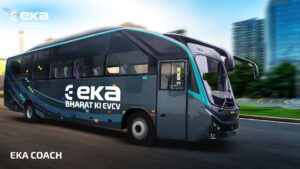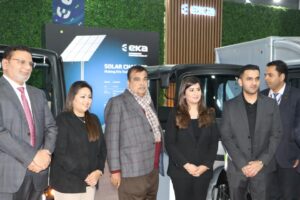Mr. Rohit Srivastava, Chief Growth Officer at EKA Mobility, emphasized the company’s commitment to making electric mobility accessible to a wide range of customers. In an exclusive interaction with Bus Coach India Magazine, he highlighted that EKA Mobility is dedicated to ensuring that electric vehicles are within reach for all individuals who aspire to embrace sustainable transportation.
He further elaborated that the company does not limit its offerings to a specific segment but rather welcomes anyone interested in purchasing their vehicles. The only prerequisite is that prospective buyers must meet the necessary financial requirements. By maintaining this inclusive approach, EKA Mobility aims to accelerate the adoption of electric mobility across various customer segments, reinforcing its vision of a cleaner and greener future.
With a strong focus on innovation and accessibility, EKA Mobility continues to work towards making electric vehicles a viable choice for a larger audience. Their mission aligns with the broader goal of reducing carbon footprints and promoting environmentally friendly transportation solutions.
Q: What are the products that EKA Mobility has launched at Bharat Mobility Global Expo?
EKA Mobility has launched a comprehensive range of commercial vehicles at the Bharat Mobility Global Expo, covering small commercial vehicles (SCVs), buses, and heavy-duty trucks. The SCV lineup includes three-wheelers ranging from a 500-kg three-seater to a 1,700-kg six-seater. Additionally, 1.5-ton, 2.5-ton, and 3.5-ton models have been introduced to cater to diverse commercial needs.
In the bus segment, EKA Mobility has unveiled a new coach and a low-floor bus, complementing its existing 7-meter, 9-meter, and 12-meter intra-city buses. The low-floor bus is available in left-hand drive (LHD) and right-hand drive (RHD) versions, with the RHD model set for release in India soon. For intercity travel, a 13.5-meter coach has been introduced, offering a range of 350 to 450 km per charge.
The commercial truck lineup now includes a 7-ton and a 55-ton truck, with intermediate models planned. Under the PM E-Bus Seva initiative, EKA has deployed 7-meter, 9-meter, and 12-meter intra-city electric buses, witnessing high demand. While government procurement focuses on city buses, private operators primarily purchase EKA’s coaches. All vehicles are manufactured under the “Make in India” initiative with localized assembly.
Q: What is the R&D capacity for these vehicles, and how is your company investing in EV technology?

Research and development form the backbone of our innovation. We have a dedicated R&D team of over 300 engineers, along with an additional 50 to 70 software engineers who specialize in vehicle software solutions. Since EV technology heavily depends on real-time data flow and monitoring, our software team plays a crucial role in ensuring optimal vehicle performance and battery efficiency. In total, our R&D division comprises approximately 350 highly skilled professionals, all working towards continuous innovation.
In terms of investment, we are fully committed to electric and hydrogen-powered mobility. Unlike many manufacturers, we do not produce fossil fuel-based vehicles—no diesel or CNG models. While I won’t disclose the exact financial figures, I can assure you that we have made significant investments to ensure we meet India’s growing demand for electric mobility. Furthermore, to keep up with the increasing number of orders, we are also expanding our manufacturing capacities.
Q: Are your vehicles available to private players, or are they limited to government tenders?
Our EVs are available to both government and private players. Our mission is to make electric mobility accessible to all, and we cater to anyone interested in purchasing our vehicles, provided they meet the necessary financial requirements.
Q: What is your current annual production capacity for buses?
Our current capacity stands at around 3,000 buses per year. However, our production capacity is scalable. By adding more shifts, we can increase our output. Our goal is to expand our capacity to 7,500 buses annually. We have three manufacturing plants: one in Koraang, another in Chakan (Pune), and a new facility coming up in Pitampur. The Chakan plant primarily focuses on truck and small commercial vehicle production, while Koregaon and Pitampur are dedicated to bus manufacturing.
Q: Given the rapid adoption of EVs, what is your projection for the growth of electric buses in India?
The demand for electric buses in India is enormous. If we compare our public transport penetration with China, they have around 60 buses per 10,000 people, whereas India has only 12 buses per 10,000 people. With India’s young and growing population, coupled with rapid urbanization, public transport demand is set to rise significantly in the next four to five years.
As per government announcements, India plans to introduce 800,000 buses by 2030. This presents a massive growth opportunity for the EV industry. Additionally, with stringent emission norms making fossil fuel vehicles more expensive and electric buses offering a lower total cost of ownership (TCO), there is a strong transition toward electric mobility. Over a five-year period, despite higher initial costs, an EV bus proves to be more economical than a diesel bus. More people are recognizing these financial and environmental benefits, which is driving demand.
Q: Safety is a major concern in the EV sector, particularly for school buses. What measures are you implementing to enhance safety?
Safety is our top priority, and all our vehicles comply with stringent safety standards. The structural safety of our buses remains consistent across diesel, CNG, and electric variants. We collaborate with world-class vendors and conduct rigorous testing to ensure our vehicles meet regulatory requirements set by agencies such as ARAI and ICAT.
Regarding battery safety, while there have been concerns due to past incidents, the industry has evolved significantly. Just as carrying 20 liters of diesel in a school bus is considered safe today due to regulations and experience, battery safety has also improved with enhanced technology, rigorous testing, and strict adherence to global standards. We ensure responsible innovation and stringent quality control to minimize risks.

Q: Are you currently exporting your vehicles to international markets?
While our primary focus is meeting India’s domestic demand, which is substantial, we have also started working on international expansion. We are carefully planning our market entry strategy to ensure we provide adequate service and support in foreign markets. Our goal is to expand in a phased manner to sustain quality and after-sales support.
Q: What is the vision behind this ambitious plan?
Our vision is clear—we aim to be the global volume leader in electric vehicles. Unlike many other manufacturers, we are not involved in fossil fuels at all; our focus is purely on electric and, to some extent, hydrogen-powered vehicles. Our goal is to address every possible segment in the market that can benefit from the intelligent application of EV technology.
Q: EKA has collaborated with major global players such as Mitsui and VDL Group. How do these partnerships influence your innovation and market strategies?
Our collaboration with Mitsui and VDL is foundational. EKA was born out of a partnership between Pinnacle Industries, Mitsui, and VDL. Mitsui, a 150-year-old global conglomerate, brings strong governance, business acumen, and a global footprint, allowing us to establish a head start in various markets. Reputation is critical in the commercial vehicle industry, and having Mitsui as a known backer gives us credibility from the outset.
VDL, on the other hand, provides us with advanced technology and refinement capabilities. For example, an articulated bus—currently absent in India—can be introduced swiftly through our collaboration. VDL Pinnacle Engineering, another joint venture, specializes in workshop fixtures for leading automotive brands such as BMW and JLR. This expertise enables us to maintain high structural quality in our buses, which is essential for long-term performance, particularly in tenders spanning 12 years or more.
Q: What trends do you foresee shaping the electric commercial vehicle industry in the next five years, and how is EKA preparing for the competition?
The future is undoubtedly electric. Factors such as urban congestion, environmental concerns, and economic viability all point toward the widespread adoption of EVs. Public transport will increasingly transition to EVs, and we are at the forefront of this transformation.
Economically, any vehicle covering 400 kilometers daily will be more cost-effective as an EV compared to fossil fuel alternatives. In smaller commercial vehicles, the lower initial cost and solutions like solar charging will further drive adoption. Stricter emission norms and increasing fuel costs will also make EVs the preferred choice over time. Given these factors, we are highly optimistic about our future and the role EKA will play in leading this transition.